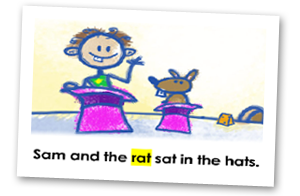First Grade Reading Activities & Curriculum Standards
A good first grade reading program curriculum relies on many learning tools – first grade reading worksheets, reading activities, reading games, reinforcement exercises, and assessments. First grade language arts lessons should cover all English language arts strands.
The major language arts strands for a first grade reading program are vocabulary development, reading comprehension, literature, writing strategies, writing applications, English language conventions, listening and speaking. While these language arts strands might surprise you, they cover the basics of what a first grader should learn in reading.
First Grade Reading Program – What are the Standards and Curriculum?
First grade reading activities provide an opportunity for children to get a basic understanding of reading skills, decoding, and phonics. These young children learn through guided reading, worksheets, language arts games, and many creative methods that make the reading program fun.
Time4Learning teaches a comprehensive first grade reading curriculum using fun activities to build a solid reading foundation in the following language arts strands.
5 Steps to Teach First Grade Reading
- Vocabulary Development: A first grade reading program helps children learn the basic features of vocabulary and reading skills.
- Reading Comprehension: A first grade reading program uses guided reading to help students understand reading level appropriate literature.
- Language Arts & Reading Comprehension: Student compositions should describe and explain familiar objects, events, and experiences while extensive writing practice is an essential language arts activity.
- Literary Response: A first grade reading program offers children guided reading experience with children’s literature appropriate to the first grade reading level.
- Writing Applications & Reading Strategy: Language arts worksheets implement the first grade reading strategy by teaching children to identify and use singular and plural nouns, contractions, and singular possessive pronouns when writing or speaking.
Vocabulary Development
A first grade reading program helps children learn the basic features of vocabulary and reading skills. First grade children learn to:
- Translate letter patterns into spoken language using phonics, syllabication, and word parts
- Identify letters, words, and sentences
- Match oral words to printed words and during guided reading, and identify the author and title of each reading selection
- Classify reading level appropriate categories of words, for example, colors, foods, animals.
Phonics are important in a first grade reading program. Reading skills develop as children learn to decode elements of words using phonics including:
- Emphasize initial, medial, and final sounds in single-syllable words
- Create and state series of rhyming words, including consonant blends; add, delete, or change target sounds to change words (for example, change met to get or cat to sat)
- Blend two to four phonemes into recognizable words (for example, /b/ i/ g/ = big; /k/ i/ t/ e/ = kite)
- Segment single-syllable words into their components (for example, /d/ o/ g/ = dog; /r/ i/ ch/ = rich)
- Blend sounds into recognizable words
- Use consonant blends and long-and short-vowel patterns
- Develop reading skill of using vowel digraphs and r- controlled letter-sound associations
By the end of the school year, students are expected, through guided reading, to be able to read aloud with fluency in a manner that sounds like natural speech.
Reading Comprehension
A first grade reading program uses guided reading to help students understand reading level appropriate literature. Students are:
- Exposed to narrative and expository text, classic and contemporary literature, magazines, newspapers, and online information to encourage reading skills
- Asked to identify text that uses sequence or other logical order
- Instructed to respond to who, what, when, where, and how
- Asked to follow one-step written instructions
- To use context to resolve ambiguities about word and sentence meanings
- Demonstrate reading skill and confirm predictions about what will happen next in a text by identifying key words
- Taught to relate prior knowledge to textual information
- Asked to discuss central ideas of simple expository or narrative passages
Language Arts & Reading Comprehension:
Student compositions should describe and explain familiar objects, events, and experiences while extensive writing practice is an essential language arts activity. The first grade reading program introduces activities covering:
- Several writing genres including brief fictional and autobiographical narratives and descriptions of experiences
- Written descriptions of a real objects, people, places, and events, using sensory details
- Instructions to print legibly, spacing letters, words, and sentences correctly
- Skill to earn to write and speak with a command of standard English conventions appropriate to first grade. Sentences used should be complete and understandable
Literary Response
A first grade reading program offers children guided reading experience with children’s literature appropriate to the first grade reading level. Students learn:
- Literary terms such as theme, plot, setting, and characters, distinguishing these from structural features of the text
- Reading skills by describing elements of plot and setting, identifying characters
- To discuss each story’s beginning, middle, and end
- Collect, discuss, and write about books they’ve read
- Describe the roles of authors and illustrators, and to understand their contributions to children’s literature
*Reading Standards are defined by each state. Time4Learning bases its use of reading standards on the national bodies that recommend curriculum and standards and the interpretations of it by a sampling of states notably Florida, Texas, and California.
Writing Applicants & Reading Strategy
Language arts worksheets implement the first grade reading strategy by teaching children to identify and use singular and plural nouns, contractions, and singular possessive pronouns when writing or speaking. Additional instruction includes:
- Declarative, exclamatory, and interrogative sentences
- Introduction to the basic rules of punctuation and capitalization
- Punctuation including periods, exclamation points, or question marks at the end of sentences
- Capitalization of the first word of a sentence, names of people, and the pronoun
- Spelling of three-and four-letter short-vowel words and grade-level-appropriate sight words
- Critical listening with appropriate response to oral communication
- Speaking manner that guides the listener to understand important ideas by using proper phrasing, pitch, and modulation
Speaking orally is another important language arts activity and first grade reading is for children to deliver brief recitations and oral presentations about familiar experiences or interests that are organized around a coherent thesis statement. Additional instruction includes:
- Topic focus and use of descriptive words for people, places, things, and events with careful attention to sensory detail
- Requiring students to recite poems, rhymes, songs, and stories
- Retelling stories using good grammar and relating the sequence of story events by answering who, what, when, where, why, and how questions posed by the reading teacher
- Relate important life events and personal experiences in simple sequences while speaking
Additional First-Grade Reading and ELA Resources
If you’re interested in first-grade reading comprehension, you may also be interested in:
- First-Grade Curriculum and Lesson Plans to outline learning goals
- First-Grade Language Arts Curriculum
- Vocabulary and spelling words for 1st grade
Online Curriculum for Homeschool, Afterschool, and Summer Use
If you are just learning about Time4Learning, we’d suggest first looking at our interactive lesson demos.
Sign up for Time4Learning and gain access to a variety of educational materials, which will engage and challenge your child to succeed. Make Time4Learning a part of your children’s homeschool resources success.

This story is constructed using the "consonant - vowel - consonant" and "sight" words that were just taught.
In the lesson, you can click on the highlighted word and hear it spoken.











